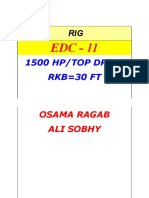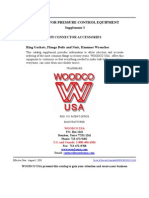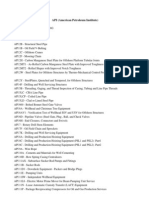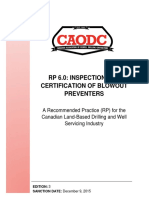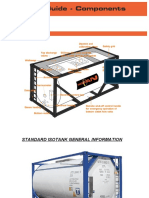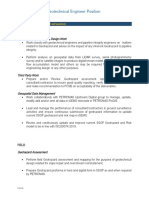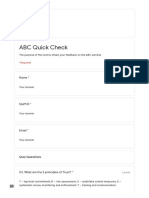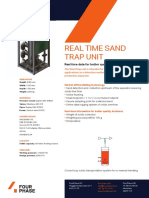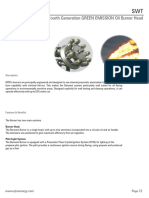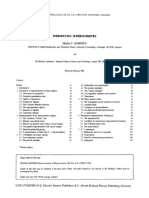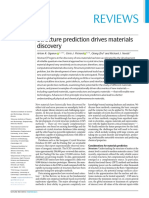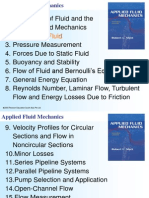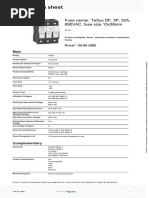API 16 C Discussion
Uploaded by
Tg TarroAPI 16 C Discussion
Uploaded by
Tg TarroAPI Spec 16C - Specification for Choke and Kill Sytems
Last update: August 22, 2013
Standard
16C
Edition
1st Edition
Jan. 1993
Section
Inquiry #
1.4.2
16C-01-09
Question
Reply
Question 1: Clause 1.4.2 states products listed in 1.2.2 that have
requirements established in API 6A shall have a minimum PSL3, Material
Class EE and a temperature rating from 3.5.2 as appropriate. Are all of
the products listed in sec. 1.2.2 covered in this category, irrespective of
PSL levels and temperature class?
Reply 1: Yes, the equipment listed in 1.2.2 must have be PSL 3,
material class EE, and a temperature rating in accordance with
3.5.2 to comply with 16C, as stated in 1.4.2.
Question 2: Is it possible to monogram a choke & kill manifold if the
requirements meet API 6A, PSL 2 and Material Class DD?
Reply 2: No, this does not comply with 1.4.2
Question 3: In a choke & kill manifold, few low alloy steel items
(crosses, tees, flanged, studded, hubs, etc.) are pressure control parts
and are material class DD. Very few items, like valves and chokes with
stainless pressure controlling parts, fall under the category of Material
Class EE, therefore, no choke and kill manifold is fully covered under
API 6A, Material Class EE. In this can this system be monogrammed
under 16C?
Reply 3: Although Section 1.4.2 refers to the material class EE, it
does not apply to crosses, tees, etc. that do not have pressurecontrolling parts. The bodies, bonnets, end, and outlet
connections (second column of the table) for Material Classes DD
and EE are the same, therefore the crosses, tees, etc. meet the
intent of the paragraph requirement when manufactured to the
Material Class EE.
The choke and kill manifold can be monogrammed under API
Spec 16C with the material class requirement of Material Class EE
for the API 6A components referenced in 1.4.2.
Page 1 of 4
API Spec 16C - Specification for Choke and Kill Sytems
Last update: August 22, 2013
Standard
16C
Edition
1st Edition
Jan. 1993
Section
Inquiry #
6.4
16C-01-08
Question
Reply
Background: We have noted that per Table 6.4.1, hydrostatic testing
and section 6.4.13 are applicable to manifold assemblies. Section 6.4.13
states: Manifold assemblies with parts having different working
pressures, the lowest rated working pressure shall be used to determine
the test pressure.
In our case we have a choke and kill manifold rated for 10,000 psi
working pressure with a 5000 psi flange on the outlet side. Based on
Section 6.4.13 we have tested the manifold to 10,000 psi (per Table
6.4.5). On the inlet side we have valves, spool adapters, studded blocks
rated for 10,000 psi of which only the valves have been tested by the
manufacturer's to 15,000 psi. The spool adapters and 5-way studded
blocks (made of 75,000 psi material) have been tested at 10,000 psi only
as part of the choke and kill manifold assembly.
Question 1: Is this testing of the spool adapters, studded blocks to
10,000 psi on the inlet side as a part of the C&K manifold testing
acceptable for a 10,000 Rated Working Pressure C&K manifold?
Question 2: Do we need to individually test the spool adapters and
studded blocks to 15,000 psi (for a 10,000 psi rated working pressure
choke and kill manifold ) before final assembly into the manifold?
Page 2 of 4
Reply 1: No. The adapters, blocks, etc. are products produced
under API 6A. These products are tested to their full test pressure
prior to installation into the manifold assembly. The only product
tested at the lower test pressure is the component with the 5000
psi flanged outlet. See 1.2.2 for other equipment included in API
16C, but covered by other API Specifications.
Reply 2: No. See Reply 1.
API Spec 16C - Specification for Choke and Kill Sytems
Last update: August 22, 2013
Standard
16C
Edition
1st Edition
Jan. 1993
Section
Inquiry #
6.4.1
16C-I-02/08
Question
Reply
Background: We have noted that per Table 6.4.1, hydrostatic testing and
section 6.4.13 are applicable to manifold assemblies. Section 6.4.13
states:
Manifold assemblies with parts having different working pressures, the
lowest rated working pressure shall be used to determine the test
pressure.
In our case we have a choke and kill manifold rated for 10,000 psi
working pressure with a 5000 psi flange on the outlet side. Based on
Section 6.4.13 we have tested the manifold to 10,000 psi (per Table
6.4.5). On the inlet side we have valves, spool adapters, studded blocks
rated for 10,000 psi of which only the valves have been tested by the
manufacturer's to 15,000 psi. The spool adapters and 5-way studded
blocks (made of 75,000 psi material) have been tested at 10,000 psi only
as part of the choke and kill manifold assembly.
Question 1: Is this testing of the spool adapters, studded blocks to
10,000 psi on the inlet side as a part of the C&K manifold testing
acceptable for a 10,000 Rated Working Pressure C&K manifold?
Reply 1: No. The adapters, blocks, etc. are products produced
under API 6A. These products are tested to their full test pressure
prior to installation into the manifold assembly. The only product
tested at the lower test pressure is the component with the 5000
psi flanged outlet. See 1.2.2 for other equipment included in API
16C, but covered by other API Specifications.
Question 2: Do we need to individually test the spool adapters and
studded blocks to 15,000 psi (for a 10,000 psi rated working pressure
choke and kill manifold ) before final assembly into the manifold?
Reply 2: Yes. See Reply 1.
Page 3 of 4
API Spec 16C - Specification for Choke and Kill Sytems
Last update: August 22, 2013
Standard
Edition
Section
Inquiry #
16C
1st Edition
Jan. 1993
16C-02-08
Question
Background: Sections 9, 9.1, 9.2, and 9.3 outline the performance
verification procedures. It does not specifically state that these
performance verification procedures shall be done for all products
covered by API 16C. In further parts of Section 9, specific performance
verification procedures and requirements are given for various products
(i.e. non-metallic seals, drilling chokes and actuators, flexible choke and
kill lines, and articulated choke and kill lines) and these earlier sections
are then referenced in each equipment's individual section.
Reply
Yes. It is the intent that all products listed in 1.2.1 are tested in
accordance with the requirements of the API 16C. Although there
are no moving parts, the temperature/pressure cycle may exhibit
problems related to the thermal expansion and contraction of the
product.
Is it a requirement that all other components covered by API 16C, but do
not have a reference to performance verification procedures in their
specific section (i.e. Section 9.6: Unions and Swivel Joints), also have a
performance verification testing done in accordance with Sections 9.3
which requires temperature cycle testing?
16C
1st Edition
Jan. 1993
9.9
16C-01-11
Are adjustable drilling chokes intended for full sealing from at the valve
seat in accordance with Clauses 6.4.6.3, 9.9.10, 9.9.11, and 9.10.3.6
(Point 3 and 6) of API 16C?
16C
1st Edition
Jan. 1993
10.9
16C-01-13
Question 1: Regarding Section 10.9, is the intent of these requirements
that the chokes can be controlled from at least one remote (not at the
choke manifold) location?
Question 2: If more than one remote console is available, is each
required to meet the functional requirements of 10.9.1?
Reply 2: This issue is outside the scope of API 16C. The API 16C
task group will study this issue for possible inclusion in a future
addendum or edition of the standard.
Question 3: Can one remote console have all the required gauging but
no backup power system (i.e. hand pump) and conform to API 16C?
Reply 3: See Reply #2.
Question 4: If one remote has a full complement of gauging and backup
power, can an alternate only have a partial compliment of functional
requirements?
16C
1st Edition
Jan. 1993
9.14.2
16C-02-09
Although API 16C, Clause 9.9, states drilling chokes are not
intended to be used as shut off valves, Clause 9.10.3.6 3) states
if the choke does not provide complete shut off capability, it shall
attain the maximum operating pressure contained in the choke
manufacturers written specification.
Reply 1: Yes.
Section 9.14.2 refers to Table 3.5.2.1 for the temperature rating of flexible
choke and kill lines. During the prototype test of the U temperature rated
line (-18 to +121C), we carried out the cold bending test at temperature
lower than -18C. Is it allowable to mark the hose with the actual
temperature of the test, or must the hose be marked with the
temperature given in Table 3.5.2.1?
Page 4 of 4
Reply 4: See Reply #2.
The hose must be marked in accordance with the limits as stated
in Table 3.5.2.1.
You might also like
- Guidance Note: Heritage Railway AssociationNo ratings yetGuidance Note: Heritage Railway Association10 pages
- PEUGEOT 307 407 607 806 807 406 306 106 107 FaultCodes 058750% (2)PEUGEOT 307 407 607 806 807 406 306 106 107 FaultCodes 05871 page
- Stabilizer Selection Guidelines QG Wrap Taper Angels100% (1)Stabilizer Selection Guidelines QG Wrap Taper Angels19 pages
- Torque Vs Tension Interpretation Instructions Rev 6No ratings yetTorque Vs Tension Interpretation Instructions Rev 625 pages
- API 5L Interview Questions and Answers: The Guide for Pipeline EngineersFrom EverandAPI 5L Interview Questions and Answers: The Guide for Pipeline EngineersNo ratings yet
- Grand Prideco Connection Type Lead Taper Thread Height Thread ProfileNo ratings yetGrand Prideco Connection Type Lead Taper Thread Height Thread Profile1 page
- API RP 13C: An Explanation and Answers To Frequently Asked QuestionsNo ratings yetAPI RP 13C: An Explanation and Answers To Frequently Asked Questions8 pages
- Cameron Information Sheet 94-004: Field Test ConditionsNo ratings yetCameron Information Sheet 94-004: Field Test Conditions1 page
- API Spec 16C - Union Connections 20140103No ratings yetAPI Spec 16C - Union Connections 201401032 pages
- Raw Water / Pre-Loading Reel Systems: Safety First100% (1)Raw Water / Pre-Loading Reel Systems: Safety First2 pages
- Parker Subsea Drilling. BOP Umbilicals, Hotlines and Stack HosesNo ratings yetParker Subsea Drilling. BOP Umbilicals, Hotlines and Stack Hoses7 pages
- TSS - Marine RCD Operations - Training Delivery GuideNo ratings yetTSS - Marine RCD Operations - Training Delivery Guide20 pages
- Anillos y Tipos de Tuercas y Longitudes para El EsparragosNo ratings yetAnillos y Tipos de Tuercas y Longitudes para El Esparragos27 pages
- Cameron DL Packer Assembly 11in - TC9609 - E-22No ratings yetCameron DL Packer Assembly 11in - TC9609 - E-221 page
- Al Masaood SoW - 13-3.8" Casing TRS Tools From Al Masaood Oil & Gas - BV Recom.No ratings yetAl Masaood SoW - 13-3.8" Casing TRS Tools From Al Masaood Oil & Gas - BV Recom.6 pages
- ANNEX VIII BOP Testing, Inspection, Training and Maintenance100% (1)ANNEX VIII BOP Testing, Inspection, Training and Maintenance5 pages
- Sjs Mechanical Setting Tool and MMR Cement RetainerNo ratings yetSjs Mechanical Setting Tool and MMR Cement Retainer43 pages
- API 510 Interview Questions and Answers: The Essential Guide for Pressure Vessel InspectorsFrom EverandAPI 510 Interview Questions and Answers: The Essential Guide for Pressure Vessel InspectorsNo ratings yet
- API Spec 16C - Specification For Choke and Kill SytemsNo ratings yetAPI Spec 16C - Specification For Choke and Kill Sytems4 pages
- Extension of NORSOK CO Corrosion Prediction Model For Elbow GeometryNo ratings yetExtension of NORSOK CO Corrosion Prediction Model For Elbow Geometry14 pages
- ABC Quick Check: The Purpose of This Test To Obtain Your Feedback On The ABC SeminarNo ratings yetABC Quick Check: The Purpose of This Test To Obtain Your Feedback On The ABC Seminar5 pages
- SPE Optimization of Well Performance by Use of A Semi Permanent Dynamic Desander Ted Brueren Statoil1No ratings yetSPE Optimization of Well Performance by Use of A Semi Permanent Dynamic Desander Ted Brueren Statoil130 pages
- Hydrogen Sulphide: Offshore Coshh EssentialsNo ratings yetHydrogen Sulphide: Offshore Coshh Essentials3 pages
- Safety and Health Topics - Hydrogen Sulfide - Standards - Occupational Safety and Health AdministrationNo ratings yetSafety and Health Topics - Hydrogen Sulfide - Standards - Occupational Safety and Health Administration3 pages
- How To Ensure H2S Safety On Offshore Rigs - Drilling ContractorNo ratings yetHow To Ensure H2S Safety On Offshore Rigs - Drilling Contractor10 pages
- Temporary Strainers: Cone Type Basket TypeNo ratings yetTemporary Strainers: Cone Type Basket Type1 page
- Porta Lab Model 854 (Offshore Kit) : Fann Instrument Company Included PartsNo ratings yetPorta Lab Model 854 (Offshore Kit) : Fann Instrument Company Included Parts1 page
- Fann Instrument Company Spare Parts: 206526 Spares 2 Year Offshore KitNo ratings yetFann Instrument Company Spare Parts: 206526 Spares 2 Year Offshore Kit1 page
- CPS15071 Rev00 Filter Screen Sizing Program CP63 & CP47No ratings yetCPS15071 Rev00 Filter Screen Sizing Program CP63 & CP472 pages
- QMT Energy Surface Well Testing (SWT) - Fourth Generation Green Emission Oil Burner Head PDFNo ratings yetQMT Energy Surface Well Testing (SWT) - Fourth Generation Green Emission Oil Burner Head PDF2 pages
- USACE Technical Guidelines For Environmental Dredging of Contaminated Sediments100% (1)USACE Technical Guidelines For Environmental Dredging of Contaminated Sediments11 pages
- Spacing Requirements For Waffle Ceilings PDFNo ratings yetSpacing Requirements For Waffle Ceilings PDF15 pages
- College of Our Lady of Mercy of Pulilan Foundation IncNo ratings yetCollege of Our Lady of Mercy of Pulilan Foundation Inc2 pages
- Attachment 4.5 - de SSB F 16 Rev 2 Visual Inspection ReportNo ratings yetAttachment 4.5 - de SSB F 16 Rev 2 Visual Inspection Report3 pages
- PALO ALTO - Getting Started: Quality of ServiceNo ratings yetPALO ALTO - Getting Started: Quality of Service12 pages
- Reviews: Structure Prediction Drives Materials DiscoveryNo ratings yetReviews: Structure Prediction Drives Materials Discovery18 pages
- Diesel Exhaust Fluid Pump - Remove and Install: Shutdown SISNo ratings yetDiesel Exhaust Fluid Pump - Remove and Install: Shutdown SIS6 pages
- Physical Science Grade 10 March 2024 VERSION TWO MemoNo ratings yetPhysical Science Grade 10 March 2024 VERSION TWO Memo6 pages
- Schneider Electric - TeSys-DF-and-LS1 - DF103No ratings yetSchneider Electric - TeSys-DF-and-LS1 - DF1034 pages
- Study of Turbo Super Charger in Diesel Locomotives.: Diesel Loco Shed, KazipetNo ratings yetStudy of Turbo Super Charger in Diesel Locomotives.: Diesel Loco Shed, Kazipet47 pages
- PEUGEOT 307 407 607 806 807 406 306 106 107 FaultCodes 0587PEUGEOT 307 407 607 806 807 406 306 106 107 FaultCodes 0587
- Stabilizer Selection Guidelines QG Wrap Taper AngelsStabilizer Selection Guidelines QG Wrap Taper Angels
- Torque Vs Tension Interpretation Instructions Rev 6Torque Vs Tension Interpretation Instructions Rev 6
- API 5L Interview Questions and Answers: The Guide for Pipeline EngineersFrom EverandAPI 5L Interview Questions and Answers: The Guide for Pipeline Engineers
- Grand Prideco Connection Type Lead Taper Thread Height Thread ProfileGrand Prideco Connection Type Lead Taper Thread Height Thread Profile
- API RP 13C: An Explanation and Answers To Frequently Asked QuestionsAPI RP 13C: An Explanation and Answers To Frequently Asked Questions
- Cameron Information Sheet 94-004: Field Test ConditionsCameron Information Sheet 94-004: Field Test Conditions
- Raw Water / Pre-Loading Reel Systems: Safety FirstRaw Water / Pre-Loading Reel Systems: Safety First
- Parker Subsea Drilling. BOP Umbilicals, Hotlines and Stack HosesParker Subsea Drilling. BOP Umbilicals, Hotlines and Stack Hoses
- TSS - Marine RCD Operations - Training Delivery GuideTSS - Marine RCD Operations - Training Delivery Guide
- Anillos y Tipos de Tuercas y Longitudes para El EsparragosAnillos y Tipos de Tuercas y Longitudes para El Esparragos
- Al Masaood SoW - 13-3.8" Casing TRS Tools From Al Masaood Oil & Gas - BV Recom.Al Masaood SoW - 13-3.8" Casing TRS Tools From Al Masaood Oil & Gas - BV Recom.
- ANNEX VIII BOP Testing, Inspection, Training and MaintenanceANNEX VIII BOP Testing, Inspection, Training and Maintenance
- Sjs Mechanical Setting Tool and MMR Cement RetainerSjs Mechanical Setting Tool and MMR Cement Retainer
- API 510 Interview Questions and Answers: The Essential Guide for Pressure Vessel InspectorsFrom EverandAPI 510 Interview Questions and Answers: The Essential Guide for Pressure Vessel Inspectors
- API Spec 16C - Specification For Choke and Kill SytemsAPI Spec 16C - Specification For Choke and Kill Sytems
- Extension of NORSOK CO Corrosion Prediction Model For Elbow GeometryExtension of NORSOK CO Corrosion Prediction Model For Elbow Geometry
- ABC Quick Check: The Purpose of This Test To Obtain Your Feedback On The ABC SeminarABC Quick Check: The Purpose of This Test To Obtain Your Feedback On The ABC Seminar
- SPE Optimization of Well Performance by Use of A Semi Permanent Dynamic Desander Ted Brueren Statoil1SPE Optimization of Well Performance by Use of A Semi Permanent Dynamic Desander Ted Brueren Statoil1
- Safety and Health Topics - Hydrogen Sulfide - Standards - Occupational Safety and Health AdministrationSafety and Health Topics - Hydrogen Sulfide - Standards - Occupational Safety and Health Administration
- How To Ensure H2S Safety On Offshore Rigs - Drilling ContractorHow To Ensure H2S Safety On Offshore Rigs - Drilling Contractor
- Porta Lab Model 854 (Offshore Kit) : Fann Instrument Company Included PartsPorta Lab Model 854 (Offshore Kit) : Fann Instrument Company Included Parts
- Fann Instrument Company Spare Parts: 206526 Spares 2 Year Offshore KitFann Instrument Company Spare Parts: 206526 Spares 2 Year Offshore Kit
- CPS15071 Rev00 Filter Screen Sizing Program CP63 & CP47CPS15071 Rev00 Filter Screen Sizing Program CP63 & CP47
- QMT Energy Surface Well Testing (SWT) - Fourth Generation Green Emission Oil Burner Head PDFQMT Energy Surface Well Testing (SWT) - Fourth Generation Green Emission Oil Burner Head PDF
- USACE Technical Guidelines For Environmental Dredging of Contaminated SedimentsUSACE Technical Guidelines For Environmental Dredging of Contaminated Sediments
- College of Our Lady of Mercy of Pulilan Foundation IncCollege of Our Lady of Mercy of Pulilan Foundation Inc
- Attachment 4.5 - de SSB F 16 Rev 2 Visual Inspection ReportAttachment 4.5 - de SSB F 16 Rev 2 Visual Inspection Report
- Reviews: Structure Prediction Drives Materials DiscoveryReviews: Structure Prediction Drives Materials Discovery
- Diesel Exhaust Fluid Pump - Remove and Install: Shutdown SISDiesel Exhaust Fluid Pump - Remove and Install: Shutdown SIS
- Physical Science Grade 10 March 2024 VERSION TWO MemoPhysical Science Grade 10 March 2024 VERSION TWO Memo
- Study of Turbo Super Charger in Diesel Locomotives.: Diesel Loco Shed, KazipetStudy of Turbo Super Charger in Diesel Locomotives.: Diesel Loco Shed, Kazipet







































